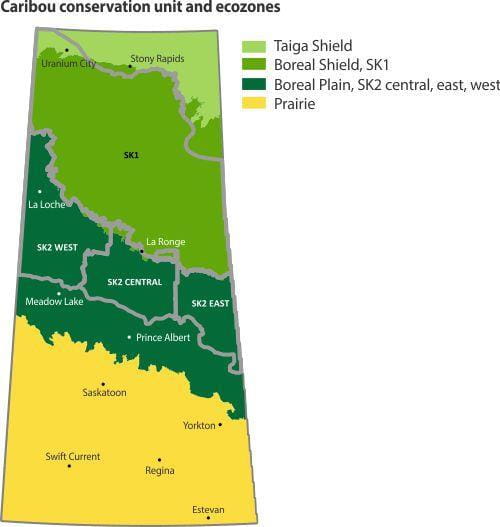
The quantity, quality and availability of habitat is an essential component of species management. Habitat connectivity, barriers to animal movement and the amount of human disturbance are monitored to develop range plans for species of interest.
What's happening

What we are doing
Woodland caribou are listed as "threatened" under the federal Species at Risk Act (SARA). In 2015, range planning was initiated across the province, with a focus on the central Boreal Plain. The final Range Plan for Woodland Caribou in Saskatchewan: Boreal Plain Ecozone for the SK2 Central and SK2 West caribou administration units were released in July 2019, and October 2021 respectively. Range plans for the other caribou administrative and conservation unit are in development.
The Woodland Caribou Range Assessment Program incorporates research to help determine the status of woodland caribou populations and habitat and provides important data for range planning. Research projects are examining population status, structure and distribution, and habitat availability and use. Currently, population trends are known for SK1 (stable) and SK2 Central (declining). Population trends for SK2 West and SK2 East require one more year of data collection, with anticipated results in 2023.
As required under SARA, Canada developed and released the Recovery Strategy for the Woodland Caribou Boreal Population in Canada in October 2012. The document identifies 65 per cent undisturbed habitat in a range as the disturbance management threshold, which provides a measurable probability (60 per cent) for a local population to be self-sustaining.
The proportion of each ecosite reflected within the Boreal Plain ecozone reflects the quantity of potential habitat available to any number of species, but does not take into account effects of human activities on the current suitability of the ecosite. By interpreting the relative importance of these ecosites for species of interest (e.g., woodland caribou), we can assess if sufficient quantities of habitat are available to them. The Forest Management Planning Standard of the Saskatchewan Environmental Code helps reduce the likelihood of habitat loss.
Range assessment and planning activities have been divided into the Boreal Shield (SK1) and Boreal Plain (SK2) conservation units as identified in the provincial and federal management strategies.



* - Data source for woodland caribou habitat potential is available from - The Saskatchewan Ministry of Environment GeoHub

* Data source for woodland caribou habitat disturbance is available from Environment and Climate Change Canada
Saskatchewan's focus is on maintaining healthy forest landscapes for woodland caribou and other species. This will be achieved by managing human-caused disturbance, altering the patterns of human-caused disturbance, and maintaining adequately-sized patches of undisturbed high-value caribou habitat of various ages with connectivity between and within caribou administration units. Within the SK2 Central area, landscape management goals are:
- Maintain or reduce the amount of human-caused disturbance based on current levels.
- Maintain greater than or equal to 80 per cent of high-potential woodland caribou habitat in a condition unaffected by direct and/or indirect human-caused disturbance.
- Maintain adequate connectivity between different areas of SK2 Central and adjacent caribou administration units and the SK1 caribou administrative unit.
- Through forest harvesting, create natural forest patterns that more closely resemble the range of variation of natural disturbances, both in distribution and scale.
- Decrease the total amount of non-permanent legacy roads.
Within the SK2 West caribou administrative unit, landscape management goals are:
- Reduce the amount of human-caused disturbance.
- Maintain greater than or equal to 80 per cent of high potential woodland caribou habitat in a condition unaffected by human-caused disturbance.
- Maintain adequate connectivity between the SK2 West and adjacent caribou administration units and jurisdictions.
- Increase forest harvest event sizes to more closely emulate natural forest patterns.
- Decrease the total amount of non-permanent linear features.
Qualitative data collected from traditional ecological knowledge suggests that populations of woodland caribou have been declining across the SK2 caribou conservation unit, which largely overlaps with the commercial forest. Woodland caribou range retraction and reductions in population size are associated with higher levels of human disturbance. The greatest contributor by total area to human disturbance across the commercial forest is forest harvesting.
Saskatchewan has identified five primary management strategies that can be taken to reduce landscape disturbance. These strategies include reclamation and restoration, mitigation offsets for new disturbances, forest harvest patterns, access management and avoidance.
Why it matters
Woodland caribou do not contribute directly to the economy of Saskatchewan, as it is not a game species for which licences are issued. Caribou are an indicator species that help represent the overall condition of ecosystem health and ecological integrity.
Due to woodland caribou being ranked nationally as a threatened species, allowing further decline of either the population or its habitat could result in emergency orders that would have a significant effect on Saskatchewan's northern industrial sectors.
The goal of the Saskatchewan Woodland Caribou Range Plan is to achieve and maintain a self-sustaining population by managing habitat availability while allowing for continued economic activity in northern Saskatchewan.
Range plans are being prepared to mitigate the negative effects of human disturbance on woodland caribou. These plans will identify strategies and actions that work towards maintaining a self-sustaining population of woodland caribou. One of the strategies identified includes following a natural forest pattern of harvesting that more similarly reflects natural disturbance patterns, distribution, and area of disturbance. This strategy is also reflected in the Forest Management Planning Standard of the Saskatchewan Environmental Code.
